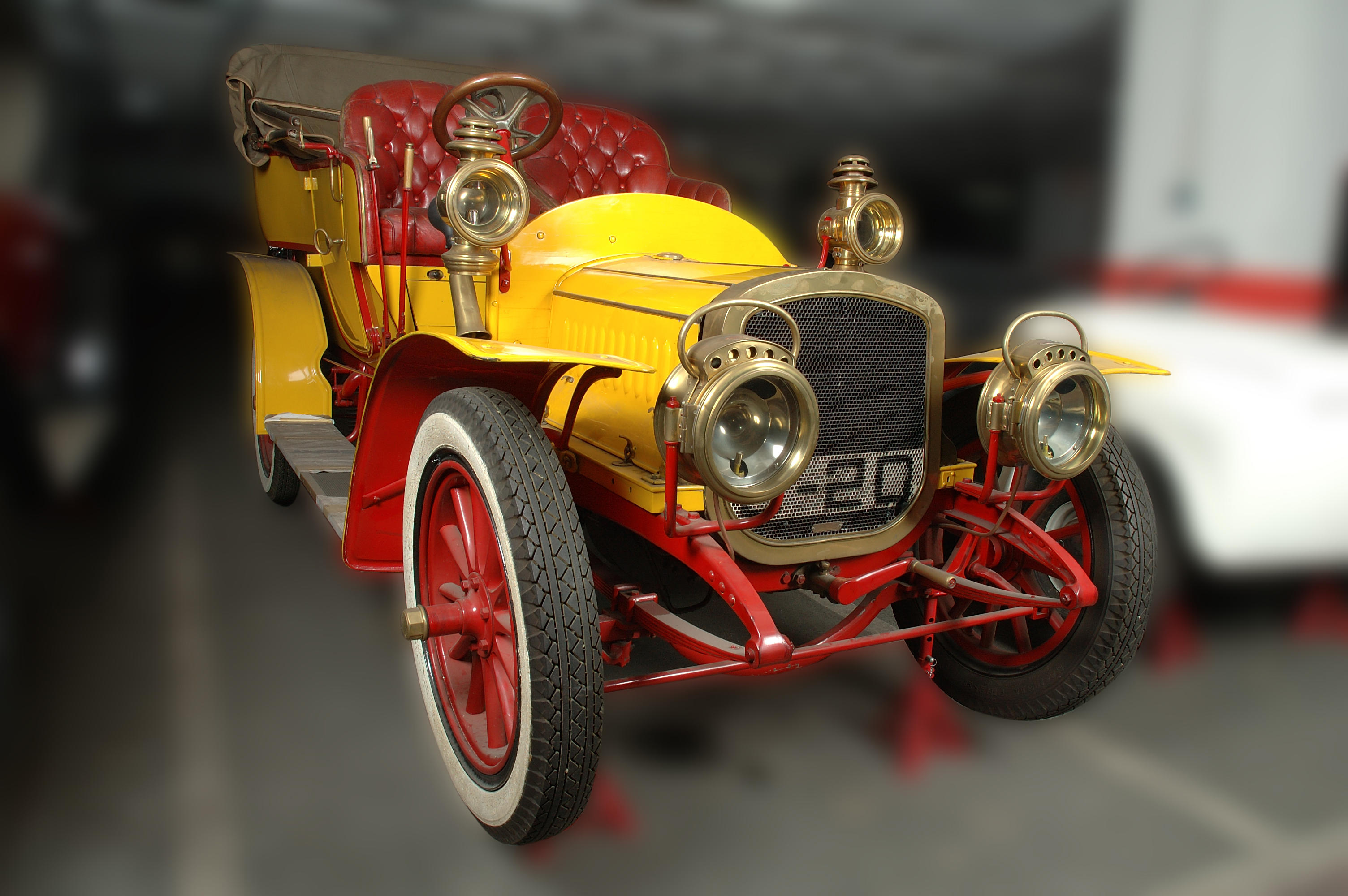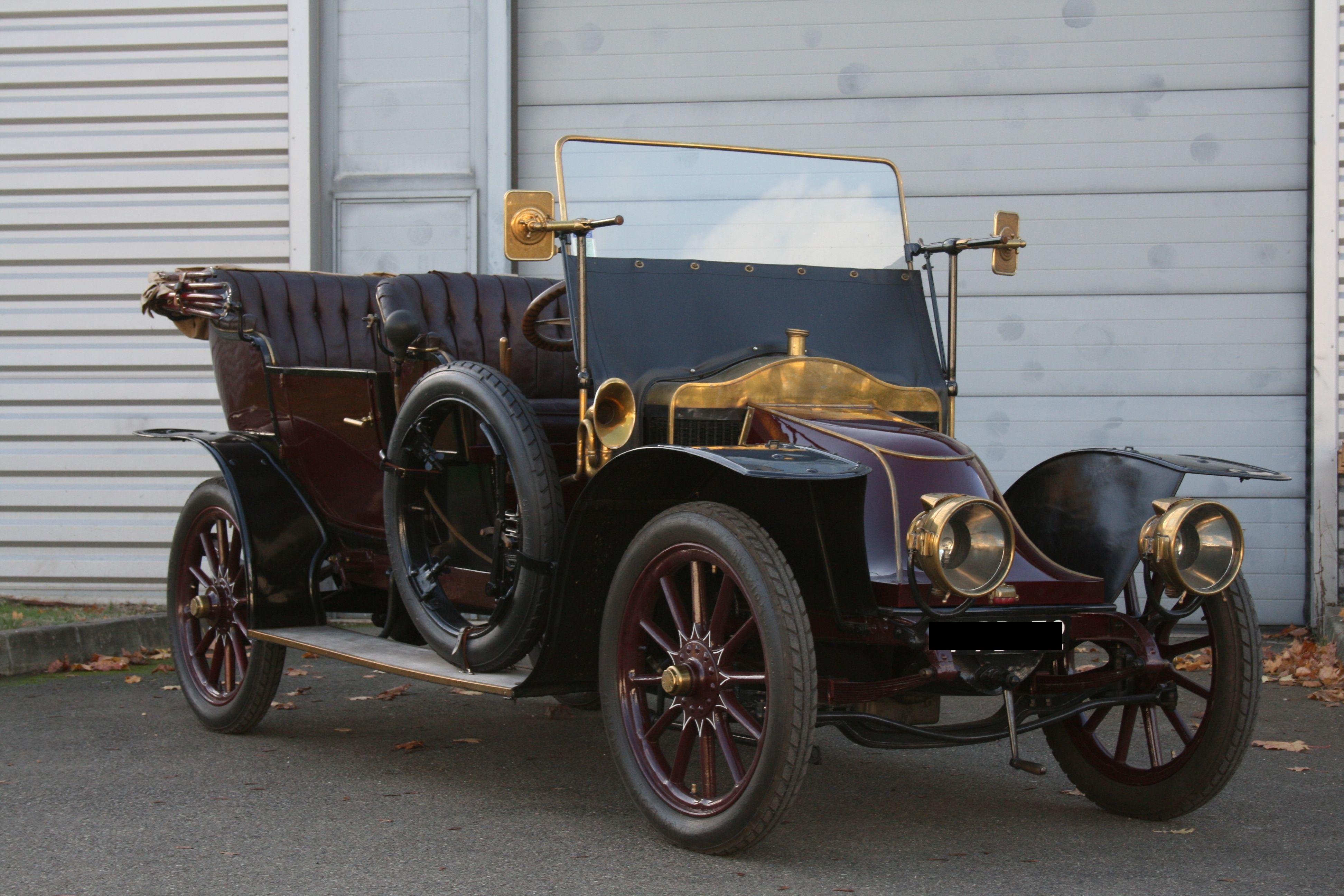1897 PANHARD-LEVASSOR TYPE M2F SINGLE PHAETON WITH HOOD Registration No. Not Registered. Car No. None given by Panhard-Levassor at this period. Engine No. 1066 Black with yellow wheels and coachlining Engine: Panhard-Levassor "Daimler-Phénix" vertical twin-cylinder, 1.65 litres, with hot-tube ignition; Gearbox: Four-speed and reverse; Suspension: full-elliptic front, semi-elliptic rear; Brakes: external contracting bands on rear wheels, transmission brake; Wooden chassis; Wooden wheels shod with solid rubber tyres; Final drive: side chains ( missing ); Tiller-steered. In the decade up to 1900 most motorists who wanted 'the best car in the world' would have been more than content with a Panhard-Levassor. Owners of cars made by Amédée Bollée Jnr, Emile Delahaye, and particularly Armand Peugeot might not have agreed with this description. However, the successes of Panhard-Levassor's products in early motoring competitions, especially that of Emile Levassor in finishing first in the 1895 Paris-Bordeaux-Paris race, caught the public imagination and, whatever the merits of the argument, for those who could afford it, a Panhard-Levassor was the car to have. The first few prototype Panhard-Levassors of 1890 were mid-engined but a change was soon made to the système Panhard whereby the German Daimler V-twin engines that Panhard-Levassor were building under licence were placed at the front of the chassis, drive went via a clutch to an exposed gear train, connecting to the rear axle by chain. Designer Levassor was not the first to use this arrangement, Amédée Bollée Snr. had used it on his steam carriages, but it was the Panhard-Levassor firm that popularised it. Whatever the merits of rear and mid-engined layouts in the early days, it was the système Panhard that became the norm for almost every motor car maker for many years to come. The car offered here is fitted with a vertical, parallel twin-cylinder engine of the type introduced by Panhard-Levassor in 1895. Delivered at Christmas 1897 to the French motor dealers Barthélémy et Cie who had premises just off the Champs Elysées in Paris, the car apparently migrated its way to the south of France where it was discovered in the 1970s. When found, all the mechanical components had been built into a lengthened steel chassis of robust proportions, the rear wheels had been cut down to the same diameter as the front and broader rims fitted, it appearing that in later life the car had been modified for commercial use. Once in the UK restoration of the car was undertaken by the well known motoring enthusiast David Baldock, together with his father, using surviving original Panhard-Levassors for guidance, particularly the example in the Hull Museum. A new wooden chassis which the car would have had when it left the factory was made, thus giving the car its correct specification and 1.7 metre wheelbase. When restoring the mechanical elements and the running gear every effort was made to keep and refurbish original components, rather than replace with new items. For example, the road springs contained all the usable original leaves with the minimum number of new ones. Crucial elements such as the engine, clutch, gearbox, both axles and their associated parts, all brakes, and the wheel hubs are original Panhard-Levassor (the axles are of course by their supplier Les Forges Lemoine ). Missing ancillaries like the carburettor, burner box, lubricators, and water-pump were either replaced with surviving period parts or, as for example in the case of the water-pump, with reproduction items of high quality. The wooden bonnet is new, to the correct pattern, and the two-seater Phaeton bodywork was obtained from the remnants of an entirely separate period motor car of unknown make and then restored. The barouche-style hood had the wooden bows renewed and was recovered, but the original iron-work is evident. Although following restoration the engine was run using jury-rigged electric ignition, the ca
1897 PANHARD-LEVASSOR TYPE M2F SINGLE PHAETON WITH HOOD Registration No. Not Registered. Car No. None given by Panhard-Levassor at this period. Engine No. 1066 Black with yellow wheels and coachlining Engine: Panhard-Levassor "Daimler-Phénix" vertical twin-cylinder, 1.65 litres, with hot-tube ignition; Gearbox: Four-speed and reverse; Suspension: full-elliptic front, semi-elliptic rear; Brakes: external contracting bands on rear wheels, transmission brake; Wooden chassis; Wooden wheels shod with solid rubber tyres; Final drive: side chains ( missing ); Tiller-steered. In the decade up to 1900 most motorists who wanted 'the best car in the world' would have been more than content with a Panhard-Levassor. Owners of cars made by Amédée Bollée Jnr, Emile Delahaye, and particularly Armand Peugeot might not have agreed with this description. However, the successes of Panhard-Levassor's products in early motoring competitions, especially that of Emile Levassor in finishing first in the 1895 Paris-Bordeaux-Paris race, caught the public imagination and, whatever the merits of the argument, for those who could afford it, a Panhard-Levassor was the car to have. The first few prototype Panhard-Levassors of 1890 were mid-engined but a change was soon made to the système Panhard whereby the German Daimler V-twin engines that Panhard-Levassor were building under licence were placed at the front of the chassis, drive went via a clutch to an exposed gear train, connecting to the rear axle by chain. Designer Levassor was not the first to use this arrangement, Amédée Bollée Snr. had used it on his steam carriages, but it was the Panhard-Levassor firm that popularised it. Whatever the merits of rear and mid-engined layouts in the early days, it was the système Panhard that became the norm for almost every motor car maker for many years to come. The car offered here is fitted with a vertical, parallel twin-cylinder engine of the type introduced by Panhard-Levassor in 1895. Delivered at Christmas 1897 to the French motor dealers Barthélémy et Cie who had premises just off the Champs Elysées in Paris, the car apparently migrated its way to the south of France where it was discovered in the 1970s. When found, all the mechanical components had been built into a lengthened steel chassis of robust proportions, the rear wheels had been cut down to the same diameter as the front and broader rims fitted, it appearing that in later life the car had been modified for commercial use. Once in the UK restoration of the car was undertaken by the well known motoring enthusiast David Baldock, together with his father, using surviving original Panhard-Levassors for guidance, particularly the example in the Hull Museum. A new wooden chassis which the car would have had when it left the factory was made, thus giving the car its correct specification and 1.7 metre wheelbase. When restoring the mechanical elements and the running gear every effort was made to keep and refurbish original components, rather than replace with new items. For example, the road springs contained all the usable original leaves with the minimum number of new ones. Crucial elements such as the engine, clutch, gearbox, both axles and their associated parts, all brakes, and the wheel hubs are original Panhard-Levassor (the axles are of course by their supplier Les Forges Lemoine ). Missing ancillaries like the carburettor, burner box, lubricators, and water-pump were either replaced with surviving period parts or, as for example in the case of the water-pump, with reproduction items of high quality. The wooden bonnet is new, to the correct pattern, and the two-seater Phaeton bodywork was obtained from the remnants of an entirely separate period motor car of unknown make and then restored. The barouche-style hood had the wooden bows renewed and was recovered, but the original iron-work is evident. Although following restoration the engine was run using jury-rigged electric ignition, the ca










Try LotSearch and its premium features for 7 days - without any costs!
Be notified automatically about new items in upcoming auctions.
Create an alert